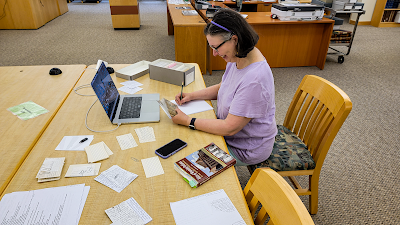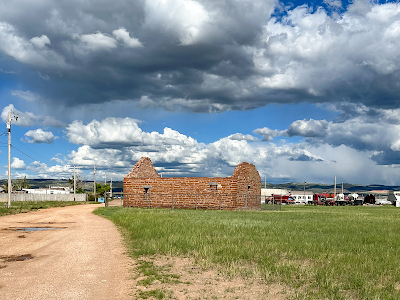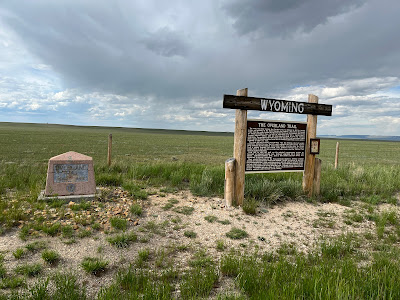Sifting through 19th century documents and struggling to decipher old-fashioned handwriting might not be your idea of a fun time but I recently spent a week at the Wyoming State Archives doing just that and it was wonderful! I stayed in a nice hotel with a kitchenette in Cheyenne, just off a highway that made it easy to drive to Laramie on the weekend.
In this post, I’ll describe my trip to Wyoming and include a few of the photos I took. You can see lots more photos on my Instagram account, PicturingTheWest, about each of the places I discuss here. Cheyenne and Laramie are fun to visit but this post would be way too long if I wrote in detail about what I did when I was in Wyoming.
I’d been to the Wyoming State Archives several years ago when I first started working on my book about the Wyoming Territorial Penitentiary but at that time, I was just gathering general information. Now that I have a clear vision for the book and have started writing it, I wanted to find information about specific aspects of the penitentiary and the inmates who were confined there.
 |
Researching at the WY State Archives; note Elnora Frye's book on table
|
The staff at the Wyoming State Archives could not have been more helpful. With their support, I was able to find a lot of the info I was looking for. They also took the photo of me conducting research. I spent Tuesday through Friday, 8:30am – 4:30pm, from the time it opened to when it closed, going through all the books and boxes of materials I’d identified as being of possible interest. (On Monday, I arrived mid-morning after first picking up a rental car.)
However, there just wasn’t enough time to read everything from start to finish so I took photos and made scans of material I thought might be useful. Tip: If you bring your own flash drive, you can make scans for free. And although I brought my Sony camera with me, taking photos with my phone was much faster and easier (and also free). Since I planned to use the photos only for research, and not publish them in the book, the quality of the images didn’t matter as long as I could read the text.
I also managed to squeeze in some sightseeing. The Wyoming State Archives is located in downtown Cheyenne in an area with several other government buildings. One day, I walked over to the Capitol, which I hadn’t seen when I was there years ago. Another day, I went to the Cheyenne Depot Museum, in the building that used to be the United Pacific Railroad depot. I wanted to ask a question about the railroad but the person I was told could answer wasn’t there.
On Saturday I drove to Laramie, where the penitentiary is located, and had the honor of meeting Elnora Frye. Elnora is the author of the Atlas of Wyoming Outlaws at the Territorial Penitentiary. The book has been an invaluable reference for my project. We talked for over 3 hours and it was a real pleasure hearing how she got started writing her book and how she found all the info. Since she wrote it before the Internet existed, Elnora did everything offline. I was very impressed!
 |
View of the Wyoming Territorial Penitentiary
|
The same day, I visited the Laramie Plains Museum. This was my fourth trip to Laramie but my first time to this museum. It’s the former home of Edward and Jane Ivinson, prominent citizens of Laramie in the late 19th and early 20th centuries. I enjoy visiting house museums and this one has several pieces of furniture made by an inmate in the penitentiary that I wanted to see because I plan to include a short biography of him in my book. I took a tour led by a very knowledgeable docent and then bought some souvenirs in the well-stocked gift shop.
 |
The large cabinet was made by John Hjorth and is in the Laramie Plains Museum
|
After that, I drove out to see the Fort Sanders Guard House, on the outskirts of Laramie. Fort Sanders was a military fort and before the penitentiary was built, local people convicted of crimes served time in the Guard House. All that’s left now of the fort is a shell of the Guard House. My book goes into much more detail about Fort Sanders and its connection to the penitentiary.
 |
All that's left of Fort Sanders is this Guard House
|
On Sunday, I drove to Laramie again and met with the site superintendent of the Wyoming Territorial Penitentiary. I had met the previous superintendent but she retired so I wanted to meet her replacement. We had a very productive meeting. Then I took a guided tour of the prison and afterwards walked around again on my own. Seeing the penitentiary never gets old, partly because there are changing exhibitions so I always learn something new each time I visit.
The Overland Trail, a major route for migrants moving West in the 19th century, passed near Laramie. I drove the 13 or so miles out of town to see a historical marker acknowledging the trail; I briefly discuss the importance of the Overland Trail in my book. The marker is just off the side of a two-lane road with an information plaque next to it. Situated in the middle of nowhere in the undulating landscape with mountains in the distance, I tried to envision what it must’ve been like for people traveling in wagons across these high plains. Turning my back to the cars whizzing by, I could just about imagine it.
 |
Overland Trail historic marker at left and information board about it at right
|
Driving from Cheyenne to Laramie and back on I-80, I passed 3 scenic sites of interest so I stopped to take a look. They were the Tree in the Rock natural feature, the Abraham Lincoln Memorial Monument, and the Ames Monument. I’ll be posting about each of these attractions on
my Instagram account soon.
If you’d like to get updates about the progress of my book, I invite you to like and follow
my Facebook page, where I’ll be sharing how things are going. I’d love to see you there!










